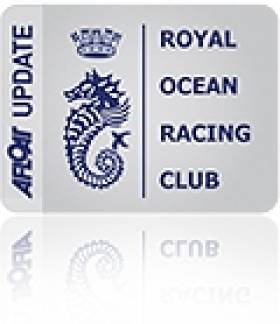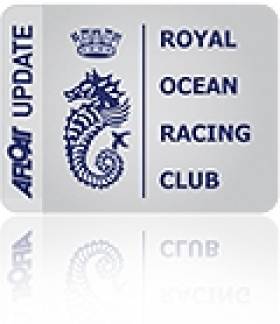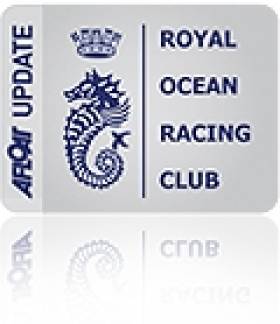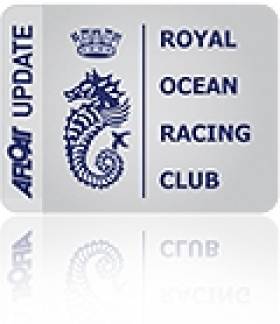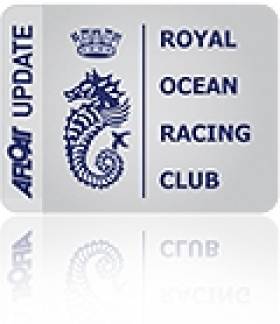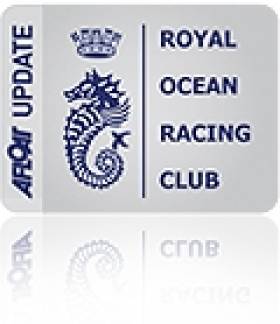Displaying items by tag: RORC
Victory for La Réponse in RORC Channel Race
This year’s Channel Race was blessed with good breeze around the 130 mile course with sunshine during the day and warm air temperature at night. The overall winner was the First 40, La Réponse, owned by Peter Morton and RORC Commodore Andrew McIrvine, by just under three minutes on corrected time from Neil Kipling’s J 122, Joopster. Charles Ivill’s Grand Soleil 54, John B, was third but did win Class Zero, against some stiff opposition.
‘It was a real surprise to win overall”, admitted Andrew co-owner of La Réponse. “Perhaps the tide favoured the medium size boats better but we made full use of it; taking a line down the south side of the island putting us in the strongest tide possible. I must say it was a real delight to have a RORC race with a 60-mile downwind leg; something that doesn’t happen to often. A boil in the bag dinner on deck, under spinnaker was a real joy. I will be back at work on Monday, just like everybody else but offshore racing is an excellent way to get away from the stress of work, much better than staring at your navel for the weekend.” La Réponse were also victors in IRC One with Neil Kipling’s J 122, Joopster, second, and Sailing Logic’s Reflex 38, Visit Malta Puma, third in class.
Class Zero winner was Charles Ivill’s Grand Soleil 54, John B, who beat several competitors against whom they will be competing in next month’s Sevenstar Round Britain and Ireland Race. “We had a very average start, having a few problems but with the No.1 headsail. We switched to the No. 2 which in the building breeze ended up to be the right sail,” commented Charles Ivill. “We had a glorious run down the south side of the island in about 14 knots of breeze. Later in the race the wind got up to about 18 knots. It was a really enjoyable race with a great crew.
“There are no rockstars on John B, we are all friends who love to sail. The youngest on board is Sam Cooper who is just sixteen, he was also on board for the Eddystone Race and the race to St.Malo. Sam won’t be with us for the Sevenstar Round Britain and Ireland, but all of the rest will.”
Second in IRC Zero was John Shepherd’s Ker 46, Fair Do’s VII, with Piet Vroon’s Ker 46, Tonnerre de Breskens, in third
In IRC Super Zero Derek Saunders’ CM 60, Venomous was the handicap winner. Venomous got off to an excellent start, leading on the water from the British Keelboat Academy’s TP52, John Merricks II, as they left the Solent. However John Merricks II fought back to take line honours, in just under 14 hours
Peter Olden’s A 35, Solan Goose of Hamble, continued their recent run of form, to win IRC Two and the Two Handed Division. Propelling them to third in IRC Two for the Season’s Points Championship. From Belgium, Eric Van Campenhout’s JPK 110, Rackham, took line honours for the class and second place on handicap with French entry, Didier Dardot’s Sphinx 33, Parisfal, claiming third.
Jean Yves Chateau’s Nicholson 33, Iromiguy, came out top in IRC Three to open up a slender lead for the Season’s Points Championship from Matthias Kracht’s JPK 9.60 Ultreia!, who was second in the race. Phoenix Yacht Club’s Starlight 39 Spellbinder of Wytch, was third.
The next RORC racing is a mixture of inshore and offshore races for the Rolex Commodores’ Cup. For full results of The Channel Race and much more visit the RORC web site: <http://www.rorc.org/> http://www.rorc.org
Antix Lines out for Channel Race
Anthony O'Leary's Antix is the sole Irish entry in the RORC Channel Race on Saturday, the last RORC offshore race prior to the Sevenstar Round Britain and Ireland Race.
Antix lines out against Round Ireland winner Tonnerre de Breskens III in a race which will last between 24-36 hours on a flexi-course. It comes just three weeks before the rest of the Irish team join Antix in the Solent for the Commodore's Cup, which starts on August 14.

Now Cork Week is over Antix is heading for Cowes. Photo: Bob Bateman
Having started the season on a flyer, Antix had to settle for third on their home waters at Cork Week, tying with Gloves Off on points but winning out on countback.
The top boat under IRC will win the Channel Challenge Cup and there are plenty of contenders.
In IRC Super Zero Derek Saunders' CM 60, Venomous, will be hoping for strong winds to propel him to victory but John Merricks II are on a roll having just won the Cowes Dinard St Malo race and will be hard to beat.
Piet Vroon's Tonnerre de Breskens 3, who is leading the Season's Points Championship by a country mile, is back after winning the Round Ireland Race earlier this month. However John Shepherd's Fair Do's VII, Chris Radford's Relentless on Incisor and Charles Ivill's John B will also be looking for a good result in IRC Zero. All of these boats go head to head in IRC Zero for this race and the 1760 mile Sevenstar Round Britain and Ireland Race next month.
Scratch boat in IRC One is Neil Kipling's J 122, Joopster, and they have some well known competition including RORC Commodore Andrew McIrvine and Peter Morton's First 40, La Réponse. Andrew McIrvine is a seasoned offshore sailor and will also be campaigning his First 40 in this year's Rolex Commodores' Cup. He had this to say prior to the Channel Race: "Many of the entries are using this race as a precursor to the Sevenstar Round Britain and Ireland Race, the biggest offshore race in the club's calendar this year. It is a long hard race, last time out the boats beat nearly the whole way around the 1760 mile course; it tests the mettle of everyone."
The Army Sailing Association's A 40, British Soldier, and Sailing Logic's Reflex 38, Visit Malta Puma, are fighting it out to lead IRC One in the Season's Points Championship and will both race round Britain and Ireland.
The top of IRC Two is dominated by two handed boats. In the Channel Race John Loden's Psipsina and Peter Olden's Solan Goose of Hamble will be looking for more success in the competitive class.
All three boats in IRC Three are at the top of the leader board. Matthias Kracht's Ultreia! the Phoenix Yacht Club's Spellbinder of Wytch, and Jean Yves Chateau's Iromiguy are sure to have a close battle.
Round Ireland Winner Vroon Starts as Channel Race Favourite
Round Ireland Race Winner Piet Vroon’s Tonnerre de Breskens 3, who is leading the Season’s Points Championship by a country mile, starts as favourite for RORC's Channel Race in nine days time. It is the last RORC offshore race prior to the Sevenstar Round Britain and Ireland Race and some well known boats will be competing in the race which will last between 24-36 hours on a flexi-course. The top boat under IRC will win the Channel Challenge Cup and there are plenty of contenders.
In IRC Super Zero Derek Saunders’ CM 60, Venomous, will be hoping for strong winds to propel him to victory but John Merricks II are on a roll having just won the Cowes Dinard St Malo race and will be hard to beat.
Piet Vroon’s Tonnerre de Breskens 3, who is leading the Season’s Points Championship by a country mile, is back after winning the Round Ireland Race earlier this month. However John Shepherd’s Fair Do’s VII, Chris Radford’s Relentless on Incisor and Charles Ivill’s John B will also be looking for a good result in IRC Zero. All of these boats go head to head in IRC Zero for this race and the 1760 mile Sevenstar Round Britain and Ireland Race next month.
Scratch boat in IRC One is Neil Kipling’s J 122, Joopster, and they have some well known competition including RORC Commodore Andrew McIrvine and Peter Morton’s First 40, La Réponse. Andrew McIrvine is a seasoned offshore sailor and will also be campaigning his First 40 in this year’s Rolex Commodores’ Cup. He had this to say prior to the Channel Race: “Many of the entries are using this race as a pre-cursor to the Sevenstar Round Britain and Ireland Race, the biggest offshore race in the club’s calendar this year. It is a long hard race, last time out the boats beat nearly the whole way around the 1760 mile course; it tests the metal of everyone.”
The Army Sailing Association’s A 40, British Soldier, and Sailing Logic’s Reflex 38, Visit Malta Puma, are fighting it out to lead IRC One in the Season’s Points Championship and will both race round Britain and Ireland.
The top of IRC Two is dominated by two handed boats. In the Channel Race John Loden’s Psipsina and Peter Olden’s Solan Goose of Hamble will be looking for more success in the competitive class.
All three boats in IRC Three are at the top of the leader board. Matthias Kracht’s Ultreia! the Phoenix Yacht Club’s Spellbinder of Wytch, and Jean Yves Chateau’s Iromiguy are sure to have a close battle.
The Race Committee will decide the course the day before the start which will be designed to suit the prevailing wind conditions.
Dave Dwyer is 'Sailor of the Month' for June
Dave Dwyer of Cork is the Afloat.ie/Irish Independent “Sailor of the Month” for June with his convincing retention of the British Open IRC Championship over three days of racing which concluded in the Solent on Sunday June 27th.
A busy month of sailing had already produced several worthy contenders for the Sailor title. But Dwyer’s performance on the final weekend with the 39ft Marinerscove.ie (designed in 2006 by current Sailor of the Year Mark Mills of Wicklow) was in a league of its own.
The boat has of course been regularly updated and optimized during four busy years at the sharp end of national and international fleets. But even in these recessionary times, there are completely new and decidedly hot contenders coming on the scene,
Thus even as the Dwyer team – and it’s a formidable equipage - was shaping up for the Solent championship, right on Mills’ own doorstep in Wicklow it was being confirmed that the overall winner of the Round Ireland Race 2010 was the 46ft Tonnere de Breskens, designed by Jason Ker in 2008.
To add to the pain, second place went to another 2008 Ker boat, the 39ft Inis Mor (Bernard Gouy, Clifden Boat Club). In fact, there wasn’t a Mills design in the entire round Ireland fleet. But within four days, marinerscove.ie had done the business and redressed the balance against an international lineup off Cowes, clinching it with four wins on the final day of racing, and catapulting Dave Dwyer into Irish sailing’s kingpin spot for June.
More from W M Nixon on Dwyer's performance in today's Irish Independent here.
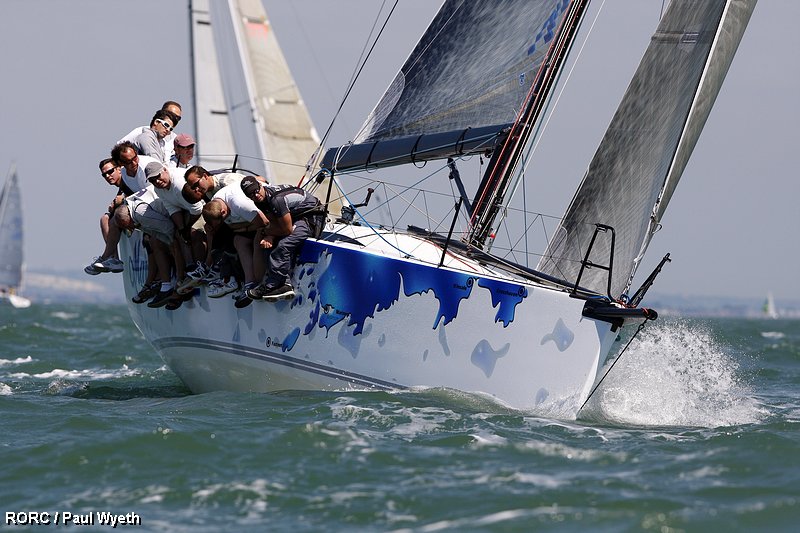
Dave Dwyer's Marinerscove in winning form on the Solent. Photo: Paul Wyeth
Biggest fleet of the Year Bound for St. Malo
The 164 mile race to St. Malo from Cowes has always been popular and with 123 boats already in, it is the biggest entry for a RORC offshore race so far this season. Unfortunately a glance at the entry list reveals there are no Irish entires to date but the size of this fleet reflects the potential Interest in offshore sailing, a shot in the arm for organisers of Irish offshore fixtures if UK and French fleets are targeted.
Mike Slade's Farr 100 Maxi, ICAP Leopard, will be hot favourite for line honours for this weekend's race to St. Malo and make no mistake; the world record breaking yacht will be attempting to break their own course record, set in 2008.
"We have held the record in four different boats, Ocean Leopard took about 19 hours, in Longabarda we took about 16 hours, Leopard of London about 15 hours and racing ICAP Leopard we got it down to about 11 hours. We will be hoping to get a good westerly wind so that we can lay the Casquets and then charge off towards St.Malo under spinnaker.
I have been doing this race for about 20 years and we are running out of restaurants that will have us! Hopefully we will be in by Saturday morning and have an enormous celebration!" commented Mike Slade.
There are sixteen RORC trophies up for grabs and there will be some intense battles right through the fleet. Four Class 40s will also be racing including World Champion, Concise, skippered by young aspiring yachtsman Tom Gall.
No less than nine A 35s will undoubtedly be swapping tacks throughout the race, including French Rolex Commodores' Cup representative, Marc Alperovitch and Jerome Huillard's, Prime Time. However, last year's IRC Two winners Franck-Yves Esco-Voiles' A 35, Ame-Hasle, will certainly be looking to retain the Yacht Club de Dinard Trophy.
Twenty six Beneteau yachts will be racing, many from France but also making the trip to St. Malo is RORC Commodore Andrew McIrvine, who will be racing his First 40, La Réponse, against three other sister ships.
Andrew McIrvine commented: "La Réponse is a new boat and a new design, so we are getting used to it and the new sails, there are a lot of tweaks to be done but we are learning more every race. It is the first boat that I have had with a fridge which is a bit of a novelty for me! So far we are pretty happy with the boat speed but there is more to come, I am sure."
Hugues Riché's Grand Soleil 44R, Spineck, was the overall winner of the prestigious King Edward VII Cup for best yacht overall in IRC. Riché has strong associations with the Yacht Club de France and after winning last year, he let the Club put the Cup on display. Spineck is back again this year and will be highly motivated to retain it.
Cowes – Dinard – St Malo Race
Organised by the Royal Ocean Racing Club in association with UNCL, Yacht Club de Dinard, Société Nautique de la Baie de St. Malo and the Royal Yacht Squadron.
Start: Friday 2nd July from the RYS, to the West.
First warning signal: 1450
Course: Cowes – Casquets - Les Hanois – St Malo. Approx. 164 miles.
Full details including on-line entry at www.rorc.org
Marinerscove Retains UK Title on the Solent
Cork's Marinerscove.ie (Dave Dwyer) has been declared RORC IRC National Champion, successfully retaining the title, a feat only ever achieved once before by Justin Slawson’s Big Cheese in 2001. Louay Habib Reports.
The tension was mounting at the start of the final day of the RORC IRC National Championship. The international fleet from Belgium, France, Great Britain, Hong Kong, Netherlands and South Africa were waiting to act out the final chapter of the championship. The seabreeze kicked in from south west at about 1100 and the fleet got into race mode for the last two races of the championship.
During the day, the southwesterly built from a wispy six knots to a stiff sixteen knots with wind over tide, giving the Western Solent some degree of swell; truly sublime racing conditions.
There were dramatic scenes right from the off with a bevy of boats infringing the start line of Race 7. Johnny Vincent’s TP52, Pace, was called over the line and got back smartly to not only recover but to win Race 7. In IRC One there were no less than five boats hauled back to restart.
The RORC IRC Super Zero title was won by Charles Dunstone’s highly impressive TP52, TEAMORIGIN Rio. Volvo Ocean winner, Jules Salter, who is currently navigating with Emirates Team New Zealand, was in the afterguard and he had this to say after their win: “It was great to be back sailing in the Western Solent, I can see my house from there! It is a place that I really call home. The tides are pretty well documented but reading the effects on the wind created by the tide is always a challenge, one that I really enjoy, it is a pleasure to sail with Charles and I count many of the crew as good friends.”
In IRC Zero Glynn Williams’ Swan 45, WISC, was four points off the lead overnight. WISC took up the challenge, nailing the start of Race 7 and battled all the way to the finish taking the bullet by less than 30 seconds on corrected time. IRC Zero went to the wire. Going into the last race, WISC was level on points with Nick Burns and Fred Kinmouth’s King 40, EFG Bank Mandrake.
John Shepherd’s Ker 46, Fair Do’s VII, won the last race of the day but WISC clinched the IRC National title for Class Zero after coming home in second place.
‘It is a big, big, big, win,” declared Glynn Williams. “When we saw the fantastic opposition in the fleet, our expectation before the start was top four, so to come here and win is very satisfying indeed. Kevin Sproul did a marvellous job at the back, as he always does but the whole crew should be congratulated; there is not a gram of emotional baggage on board, they are all a pleasure to sail with.”
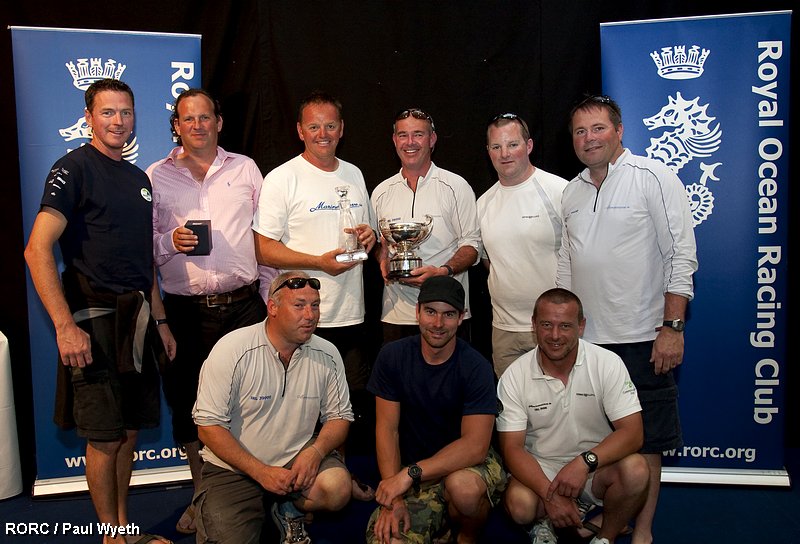
In IRC One Dave Dwyer’s Mills 39, Marinerscove.ie, continued their relentless onslaught, notching up win number four in Race 7. Peter Rutter’s Grand Soleil 43, Quokka 8, was a solid second but a battle went to the wire for third place between four boats who will be racing in the Rolex Commodores’ Cup: Christopher Opielok’s Corby 36, Rockall III, Robert Davies’ Corby 36, Roxy 6, and Philippe Delaporte’s J 122, Pen Azen. In the last race Rockall III overhauled their rivals to clinch third place.
Marinerscove.ie was also declared overall RORC IRC National Champion. Successfully retaining their title, a feat only ever achieved once before by Justin Slawson’s Big Cheese in 2001.

Andy Beadsworth has a long association with David Dwyer and had this to say at the prizegiving: “Before the championship we decided that we would judge our performance by how well we sailed rather than the result and that still stands. I believe that we covered the basics well and got our risk strategy right. The crew work has improved since we won last year and a lot of that is down to a determined effort by everyone on board to reach and maintain a high standard of boat handling. That has enhanced our boat speed which is a crucial area in any kind of yacht racing. Marinerscove.ie is in great shape for the Rolex Commodores’ Cup.”
Chris and Hannah Neve’s, No Chance, has had a cracking championship and blew the opposition away with a bullet and a second to take the IRC Two title by a healthy margin. It was evident why they have been chosen to represent England for the forthcoming Rolex Commodores’ Cup. No Chance was also awarded the Jackdaw Trophy for second best yacht overall in IRC.
“Overwhelmed, it’s absolutely fantastic to win against such high class opposition, we are so up for the Rolex Commodores’ Cup,” declared a delighted Hannah Neve.
In IRC Three Louise Morton steering Anchor Challenge was first in class beating two other Quarter Tonners; James Morland’s Menace and Mark Lees’ Espada, into second and third respectively.
Louise was not sailing her usual boat Espada but her sistership Anchor Challenge, which is usually sailed by Peter Morton who was on duty with TEAMORIGIN Rio.
“We are obviously delighted with the win and it was great to sail Anchor Challenge, we decided to sail her because she is a far more tweaky boat than Espada with additional systems such as halyard locks but I feel that the greater sail area is more suited to the boys, who weigh a fair bit more than the my all girl crew.”
Racing continues for the Royal Ocean Racing Club, on Friday 2nd July with the 164 mile Cowes – Dinard – St Malo Race in association with UNCL, Yacht Club de Dinard, Société Nautique de la Baie de St. Malo and the Royal Yacht Squadron as part of the RORC Season’s Points Championship.
One of the most competitive fleets ever assembled enjoyed some spectacular sailing conditions (as Paul Wyeth's photos over the fold show) on the first day of the 2010 RORC IRC National Championship writes Louay Habib.
Charles Dunstone’s TP52, Team Origin Rio, had a perfect start to the championship, scoring three straight bullets in IRC Super Zero. “Rio just lights up in these conditions; it was absolutely fabulous out there today,” commented Charles Dunstone after racing.
There was an intense battle on the water in IRC Zero. Hong Kong’s Rolex Commodores’ Cup big boat, Mills 40, EFG Bank Mandrake, is in pole position after three races. Joint owner, Nick Burns had this to say dockside: “That was pretty hot racing out there. Great fun and fantastic stuff. We were delighted to take two wins but our disappointing last race has left us a bit perplexed. We seemed to lose boat speed upwind and downwind. Perhaps we picked up something on the keel but we really don’t know what the issue was.”
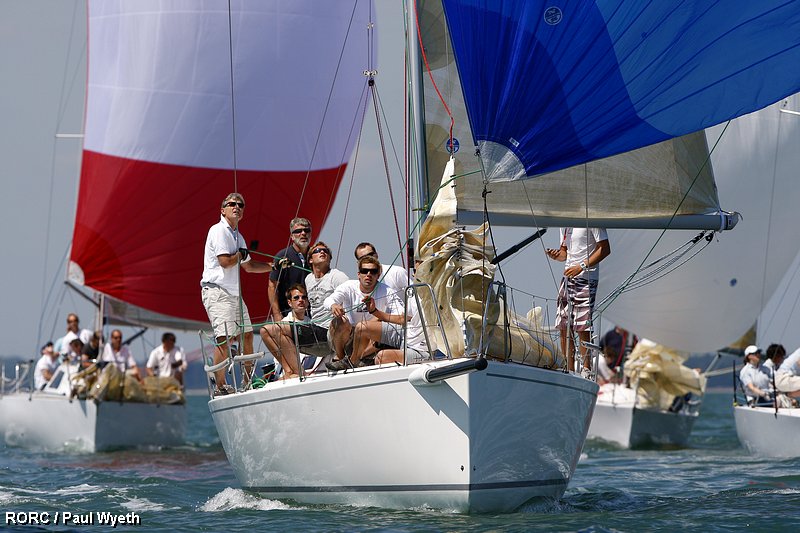
In IRC One reigning RORC IRC National Champion Dave Dwyer’s Mills 39, Marinerscove.ie, got off to a great start winning the first two races, but the last race of the day did not go according to plan. Tactician Andy Beadsworth explains: “The first two races went well for us, we sailed our own race and as the fastest boat in the class we could go our own way but it all went wrong in Race Three. We were too eager at the start and with close to three knots of tide we were over the line and had to go back. After that we misjudged a port-starboard and ended up doing penalty turns. However the recovery was good and we managed to claw our way back through the traffic for a third place.”
Marinerscove.ie leads IRC One after the first day. Peter Rutter’s Grand Soleil 43, Quokka 8, is in second place with Robert Davies’ Corby 36, Roxy 6, in third.
In IRC Two, Marc Alperovitch and Jerome Huillard’s A 35, Prime Time, had a disappointing first race but it was all smiles for the French team after that with two bullets to end the day top of the class leader board. Chris and Hannah Neve’s First 35, No Chance, is lying second over night with Steve Northmore’s A35, Waterjet.co.uk, in third place.
IRC Three may be the smallest class at the championship but virtually the entire class enjoyed a very close squabble in the western Solent. Mike and Jamie Holmes’ J 97, Jika Jika, came out on top after three races. James Morland’s Quarter Tonner, Menace, slipped up in the last race of the day but holds onto second place. Louise Morton’s Quarter Tonner, Anchor Challenge, has a very consistent day and is lying third.
Three races are scheduled for the second day of the Championship today. All of the competitors will be hoping for another fantastic day’s racing in the Solent.
Full results from Day One of the RORC IRC National Championship can be found at www.rorc.org
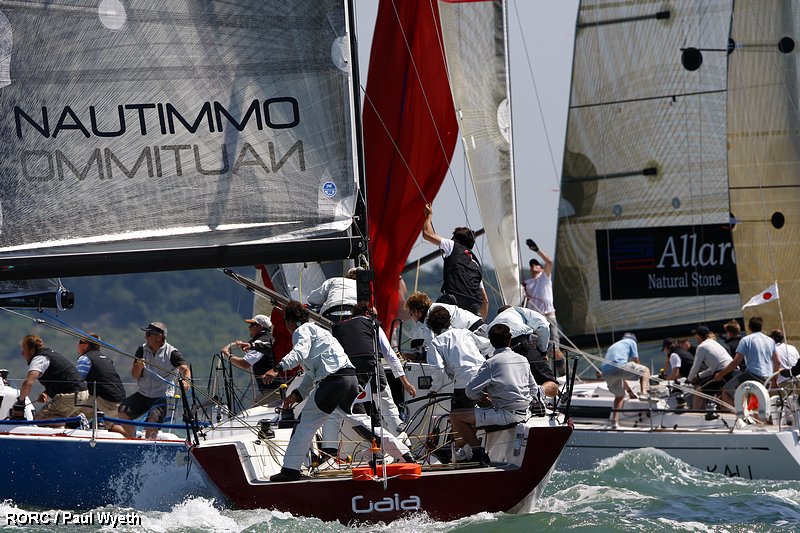
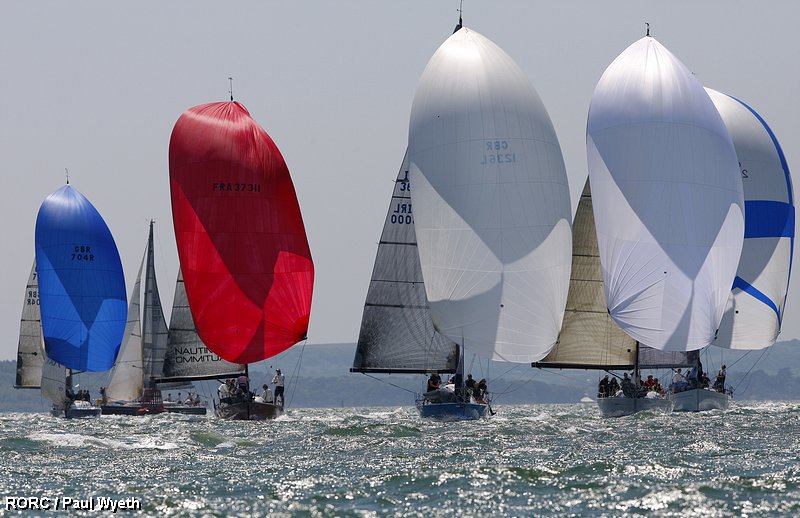
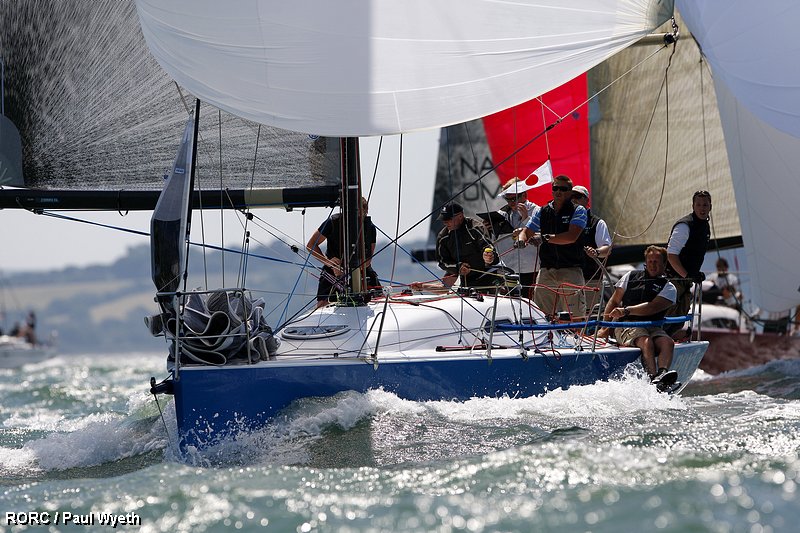
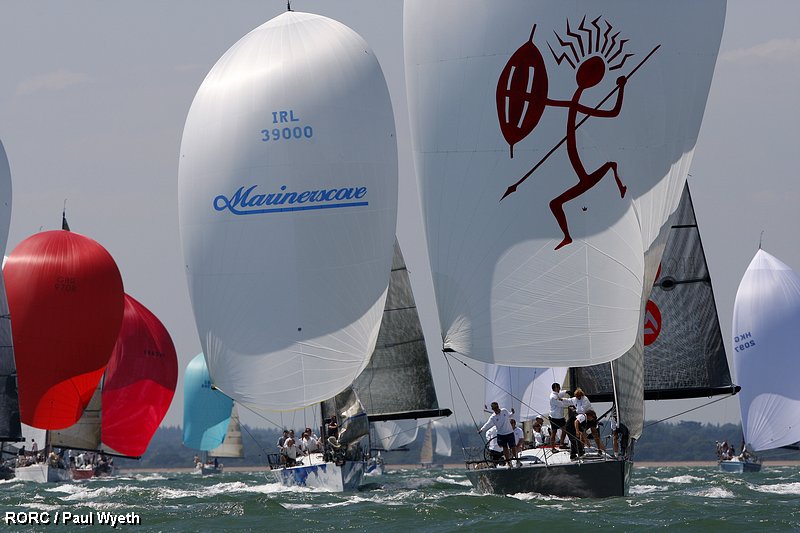


Mariners & Antix Challenge for RORC IRC Gong
Irish Commodores' Cup entrants Marinerscove.ie will head to the Solent next week to defend their RORC IRC title, shadowed by the top-ranking Irish IRC boat this year, Anthony O'Leary's Antix. Blondie IV also takes part under a Hong Kong flag.
The RORC IRC National Championship includes competitors from Belgium, France, Great Britain, Hong Kong, Ireland and the Netherlands. The international fleet contains many of the competitors that will be taking part in this year's Rolex Commodores' Cup and the scene is set for some close racing between rivals old and new. All of the classes racing at the IRC National Championship are brimming with talent.
IRC Super Zero has the mouth-watering prospect of the high performance big boat class lighting up the Solent including some TP 52s; Johnny Vincent's Pace, Charles Dunstone's TEAMORIGIN Rio, the British Keelboat Academy's John Merricks II and Rob Grey's Farr 52, Bob.
IRC Zero is virtually composed of Rolex Commodores' Cup contenders from six different countries. Anthony O'Leary's Ker 39, Antix, is the current Irish IRC Zero National Champion but only just beat Dave Dwyer's Mills 39, Marinerscove.ie, by a single point less than a month ago. However Marinerscove.ie is the reigning IRC National Champion and will not be letting go of the trophy without a struggle.
IRC One has a highly competitive international line-up. Philippe Delaporte's Pen Azen is over from France and the J 122 is a proven winner; having been awarded RORC Yacht of the Year in 2008.
"Pen Azen will be representing France in the Rolex Commodores' Cup this August," explained Philippe. "We see the RORC IRC Nationals as a perfect way to prepare for the event, the crew will be getting used to living in Cowes and the surroundings but also we will get some fantastic racing with our competition on the same race course."
IRC One also includes RORC Commodore, Andrew McIrvine, and Peter Morton's First 40 La Réponse, who will have their first inshore encounter with sister ship Coup De Coeur raced by Marc de Saint Denis and Géry Trentesaux. Other top contenders include Jim Macgregor's Elan 410 Premier Flair, and Robert Davies' brand new Corby 36, Roxy 6. IRC One should also provide some tense moments and close mark roundings with five First 40.7s amongst the high caliber fleet.
IRC Two is the largest fleet competing and includes the biggest variety of designs including David Aisher's J 109, Yeoman of Wight, Wouter Borghijs' A 35, Tontin, from Belgium and Chris and Hannah Neve's First 35, No Chance, who have been selected for the forthcoming Rolex Commodores' Cup. "The First 35 is a new design this year and we are absolutely loving the boat," explained Chris Neve. "We are really looking forward to the championship."
The scratch boat in IRC Three is Mike and Jamie Holmes' J 97, Jika Jika, who should have a close tussle on the water with Richard Sparrow's J 92, Who's To No.
There are several Quarter Tonners expected including Paul Kelsey's Runaway Bus, James Morland's Menace and Louise Morton's Espada. "This week there were 35 boats competing for the Quarter Ton Cup, enjoying some fantastic racing. It would be marvellous to see a big turn out for the RORC IRC National Championship, it is a great event and one not to be missed," said Louise.
Round Ireland Favourites Top RORC Scoreboard
Two of the favourites for the Round Ireland title topped out the RORC IRC overall listings last weekend at the Morgan Cup an overnighter to Cherbourg. The winning boat, Psipsina, was a double-handed entry sailed by Paddy Cronin and John Loden. They pipped Piet Vroon's Tonnerre de Breskens III for the overall trophy by just over two minutes on corrected time.
“I am totally gobsmacked,” admitted John Loden. “I have been racing Psipsina for 11 years and this is the biggest win by a country mile.”
Loden admitted that the falling breeze approaching Cherbourg was a decisive reason for the win and it went right to the wire. Psipsina beat Piet Vroon’s Ker 46,Tonnerre de Breskens 3, by just two minutes and thirteen seconds on corrected time to win the prestigious Morgan Cup.
The start didn’t go well for Psipsina, Loden and Cronin made a navigational error and nearly missed Trinity House buoy altogether but fortunately they managed to alter course, just in time. After that they hardly put a foot wrong.
“The majority of the fleet chose to go to the north shore in the Solent but we correctly chose to say island-side and enjoyed better breeze than our rivals,” explained Loden. “By the time we got to No Man’s Land Fort we were leading IRC Two on the water and going well. During Saturday we had a superb spinnaker run across the Channel,15 knots of steady breeze, warm air downwind sailing…terrific. One of the important factors in offshore racing is fatigue and we have never taken the macho approach of staying up when sleep is available and both of us got some rest during the day on Saturday which pays dividends.
By Saturday afternoon we were on our final approach to Cherbourg and paid great heed to the tide. Perhaps we were a little over cautious but we were going to make damn sure we were uptide and we worked hard to make this happen. As we approached the finish the wind died down to as little as 5-6 knots and we were headed. We used one of our secret weapons to make good our speed in these conditions; we have a very flat A5 which is designed as a storm sail downwind but it also doubles up as a very effective headsail in light air conditions closer to the wind.
We were pretty confident of the Class win and Paddy and I were enjoying a cold beer in the Yacht Club de Cherbourg when the RORC team told us the fantastic news. It is a moment I will treasure for a very long time.”
Piet Vroon’s Ker 46, Tonnerre de Breskens 3, won the Knightsbridge Cup for best yacht in IRC Zero and also took the RORC Salver for line honours by beating Tony Lawson’s Class 40, Concise 2, on the water. Peter Robson’s First 40.7, Playing Around Logic, took the Queensborough Cup for best yacht in IRC One. Matthias Kracht’s JPK 9.60, Ultreia! was best yacht in IRC Three, winning the Warsash Cup.
Ahead of the race, their third win in a row, Loden had said: "We had a very good reminder of what can happen if you lose your concentration in this game during the Cervantes Trophy Race. We got our approach to France all wrong and the resulting foul tide knocked us right down the pecking order. I have been racing short-handed for a few seasons now and I really enjoy the satisfaction of beating fully crewed boats. Also you learn so much when you have to do all of the work between just two of you. Probably the greatest pearl of wisdom I have learnt in short-handed racing is to take time to plan a manoeuvre, especially down wind. Gybe in haste; repent at leisure, would be a good way of summing it up."
Loden & Cronin now lead the double-handed standings, with Vroon leading RORC's overall IRC series.
IRC Morgan Cup Overall Results HERE.
RORC Morgan Cup starts Friday 11th June
Organised by the Royal Ocean Racing Club in association with the Royal Thames Yacht Club, the Yacht Club de Cherbourg and the Royal Yacht Squadron.
Unless you have been living in the remotest corner of the earth without communications, you may be aware that the FIFA World Cup kicks off this Friday. However not everybody will be glued to a television set, daring to dream of winning thecoveted trophy. Hundreds of sailors will be taking part in the RORC Morgan Cup and will miss the start of the tournament in South Africa.
The Morgan Cup marks the launch of a new Class 40, Tony Lawson’s Concise 2, on board will be one of Britain’s iconic solo sailors, Pete Goss, as Tony Lawson explains:
“For the inaugural race the new boat will be skippered by Tom Gall with Pete Goss and Ned Collier Wakefield” explained Tony Lawson. “Tom is a great example of what Concise is all about, he is a young, up and coming sailor, who has worked with PUMA during the last Volvo Ocean Race and is a bright prospect for the future, he deserves hischance. Ned has been with the team for some time but took some time out to finish his education and we are very happy to see him back on board. Pete Goss is looking to get as much time on the water as he can, before returning to solo racing on Concise 2 for the Route de Rhum, later this year. His attitude is outstanding and he brings a wealth of experience, a perfect role model for young talent.”
In IRC Zero Piet Vroon’s Ker 46, Tonnerre de Breskens 3, will be looking to continue the impressive form that has them in pole position in IRC Overall for the RORC Season’s Points Championship. However Mike Greville’s Ker 39, Erivale III, has had a good start to the season and is currently lying in second place in IRC Zero and he is a big fan of the race to Cherbourg, as he explains:
“I have to say it is one of my favourite venues for RORC racing, there is an excellent deep harbour that can fit us all in at whatever time we finish and some great restaurants. Hopefully we will finish in time for dinner on Saturday night but at the moment it is looking like a light airs race. However, that was the forecast for the Myth of Malham which turned into a windy one. We have had a good start to the season and perhaps the fact that the crew have been together for five years is one of the main reasons for our success.”
Steven Anderson’s First 40.7, Encore, is currently leading IRC One and this weekend will be racing with his wife Jane and the entire compliment of his Sevenstar Round Britain and Ireland crew. The team are all friends and family and Steven is relatively new to racing, as he explains:
“I use to do a lot of cruising but these days I really enjoy the racing. I have become fascinated with the intellectual challenge of the offshore sport, especially through the development of navigational electronics and performance relative data that is now available. We are really enjoying the battle with Sailing Logic; although we are fiercely competitive we are also great friends and this is another great aspect of this sport.”
John Loden, along with his co-skipper Paddy Cronin, are currently leading the RORC Two-Handed Division and hope to make it three wins in a row for HOD 35, Psipsina, this weekend. However Loden is not counting his chickens just yet.
“We had a very good reminder of what can happen if you lose your concentration in thisgame during the Cervantes Trophy Race. We got our approach to France all wrong and the resulting foul tide knocked us right down the pecking order. I have been racing short-handed for a few seasons now and I really enjoy the satisfaction of beating fully crewed boats. Also you learn so much when you have to do all of the work between just two of you. Probably the greatest pearl of wisdom I have learnt in short-handed racing is to take time to plan a manoeuvre, especially down wind. Gybe in haste; repent at leisure, would be a good way of summing it up.”
In IRC Three the class leader is Trevor Nicholls’ Starlight 39, Spellbinder Of Wytch. Trevor sails under the burgee of the Phoenix Yacht Club out of Haslar Marina in Gosport. The Club was formed to enable its members to enjoy sailing and to share the costs between a group of like-minded individuals. The club depends entirely on its members to ensure that the yachts are maintained to a high standard. Every time a yacht is used, the skipper and the crew are expected to leave the yacht in a better condition than they found it.
The results of the Morgan Cup will be posted, as and when available, by the RORC Race management team on the RORC web site: www.rorc.org




























